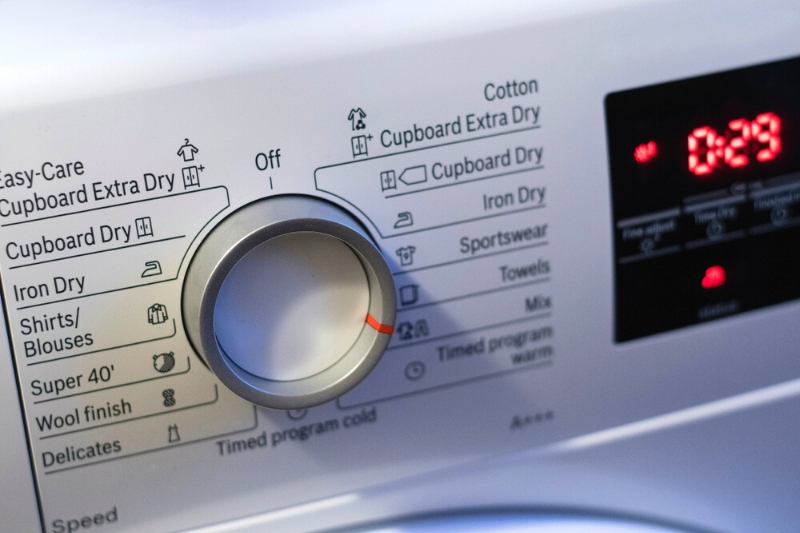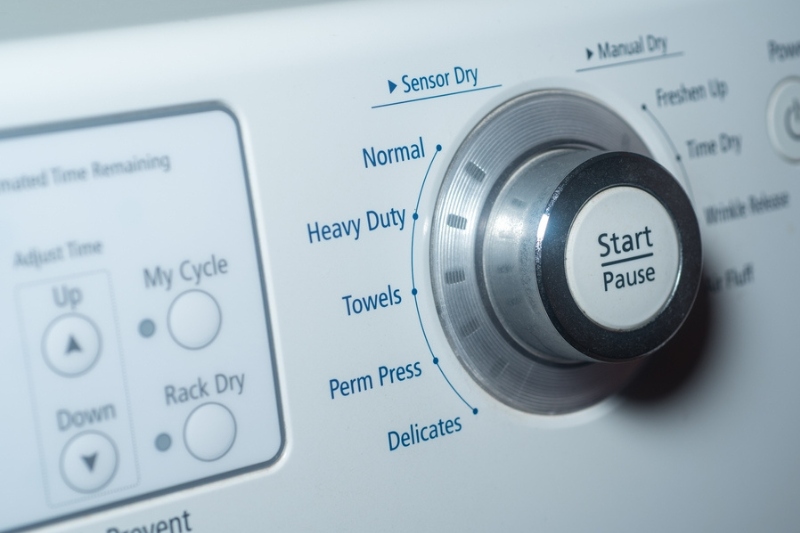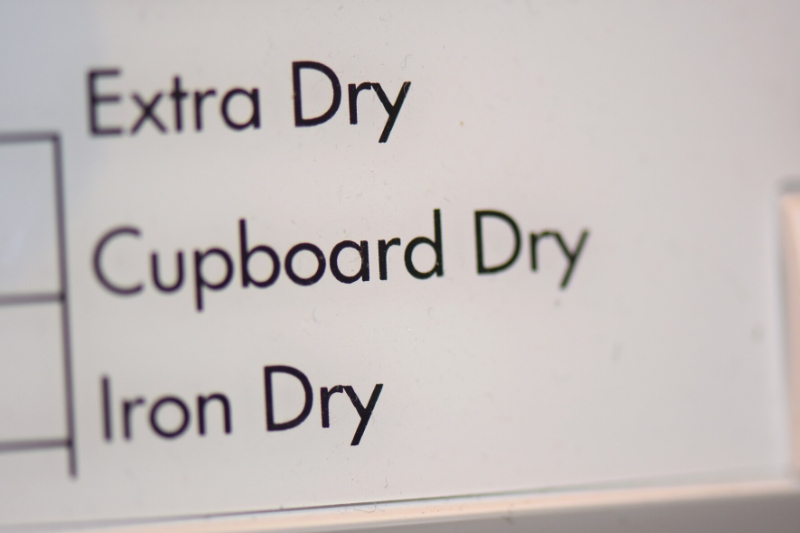Tumble dryers in the UK come with a wealth of settings that you may or may not use throughout the machine’s life.
There are so many cycles to pick from that it often feels like there’s a cycle to suit every drying need.
But two cycles, in particular, get people talking and these are: Cupboard dry and extra dry.
So, what’s the difference between extra dry and cupboard dry? Well at first glance you’d be right to say that the two names sound sort of similar. However, they are in fact quite different and shouldn’t be confused.
Learn more about cupboard dry cycles and extra dry cycles below, so you can dry your laundry more effectively!
Cupboard Dry

A ‘cupboard dry’ cycle dries your clothes to the extent that they should be dry enough to be stored in a cupboard or wardrobe.
However, some manufacturers use slightly different definitions for this type of cycle, so you should refer to your dryer’s handbook for further guidance.
When do you use the cupboard dry cycle?
The cupboard dry cycle can be used to dry laundry that needs to be stored away immediately after the drying cycle finishes.
You can dry various types of materials on this setting, but it isn’t always suitable for delicate materials, like wool.
In addition to this, you shouldn’t overfill your dryer’s drum when running such a cycle. If the clothes are packed in too much they won’t be agitated properly during the cycle.
In turn, you might have a load of unevenly dried clothes, and as a consequence, you might have to rerun the drying cycle to dry the laundry properly.
It’s also worth pointing out that dryer manufacturers’ definitions of what a cupboard dry cycle is varies slightly.
So, it would be wise to check your user handbook to see what temperature, and how long this cycle lasts on your machine before using it to clean random types of material.
Temperature and timing
The cupboard dry setting is generally a shorter cycle in comparison to an extra dry cycle. It also uses a lower temperature to dry laundry.
Do keep in mind that each manufacturer has their take on what a cupboard dry cycle is, how long it takes, and what type of heat is used. So. It’s worth reading your handbook to see how long such a cycle takes on your dryer.
Pros and cons of using cupboard dry setting
Pros
- Provided the machine hasn’t been overloaded, clothes will come out of the drum dry and ready to put away.
- Can prevent damage and shrinking because the heat may be more suitable and the cycle time is more appropriate compared to the extra dry setting.
- Usually completed quicker than an extra dry cycle.
Cons
- You might have to run an additional drying cycle if clothes are not completely dry when they come out. This is particularly likely to happen if you’ve overloaded the drum.
- The cycle may not be warm enough to dry bulkier items.
- The cycle might be too short if you have to dry heavy goods that require a longer drying time.
- It’s not necessarily a suitable cycle for all materials, particularly delicate ones.

Extra Dry
An extra dry cycle is a longer drying cycle that uses a higher heat to dry laundry, in comparison to a cupboard dry one. It is commonly used to dry large and heavy items.
This cycle can be used to dry clothes, as long as the material can withstand the extra heat and longer cycle time.
Clothes dried on this cycle are usually completely dry by the end of the cycle, so they can either be stored or worn.
In most cases, regular laundry doesn’t need to be dried on such an intense cycle, and you can/should choose a different cycle.
In some cases, this cycle is called ‘high heat’ because a lot of heat is used during this drying cycle.
When do you use the extra dry cycle?
Generally, the extra dry cycle is used to dry tougher, thicker items like bedding and towels.
It can also be used to dry hard-wearing clothes that can be dried for long periods of time and in a hotter environment.
It’s not suitable for delicate materials, like silk and wool, and you definitely shouldn’t run items that are not dryer friendly through this cycle!
If you add this kind of laundry to the drum and run an extra dry cycle, your washing will likely get damaged and shrunk.
Temperature and timing
The extra dry cycle normally takes longer to complete than a cupboard dry cycle. And the cycle typically uses a higher temperature to dry the laundry effectively.
It is, however, imperative that you check your personal tumble dryer’s handbook to see how long this cycle will actually take your machine to complete, and to discover what temperature this cycle uses.
This information is essential when you are drying laundry, as one wrong move could result in you overheating and over-drying your washing! And as a direct consequence, you could end up with a pile of damaged laundry that has shrunk.
Pros and cons of using extra dry setting
Pros
- Items are usually completely dry afterwards, and can be used or stored right away.
- Great for drying big items. You can dry larger items on this setting in a single cycle (material permitting), which can save you time in the long run (you won’t have to keep running ineffective cycles to dry your item).
Cons
- Can be a lengthy drying cycle (times vary between different makes/models).
- Not suitable for all materials.
- Might work out a tad more expensive to run as you have to run the cycle for longer and at a hotter temperature.
- Can damage fabrics.
- Can shrink some materials, particularly delicate ones.

What’s the Difference Between Extra Dry and Cupboard Dry?
Here’s a quick recap of the main difference between the two cycles:
- Extra dry is for heavy/bulky items – A cupboard dry cycle is designed to dry clothes enough so that they can be stored away immediately. An extra dry cycle, on the other hand, is designed to dry heavy and bulkier items, and to make sure they are completely dry before they are used or stored.
- Extra dry is hotter and longer – A cupboard dry cycle tends to take less time to complete and uses a lower temperature to dry laundry. In contrast to this, an extra dry cycle tends to be slightly longer (although times vary between different makes/models) and much hotter. It is for this reason that an extra dry cycle can be most costly to run.
- Extra dry is only suitable for certain materials – Further to this, you can generally dry many different types of laundry on a cupboard dry setting. But you cannot dry all materials on an extra dry cycle. The extreme heat and longer cycle would likely warp, damage or shrink some materials, particularly delicate ones. This is why this cycle is used mainly for bulkier, harder-wearing items.
You need to understand the differences between the two cycles in order to use each cycle at the right time.
By using the right cycle for the right material, you can dry your laundry effectively, which in the long term should save you time, and it should make the drying process hassle-free for you.

Bethan has a passion for exploring, reading, cooking and gardening! When she’s not creating culinary delights for her family, she’s concocting potions to keep her house clean!






